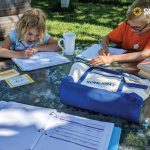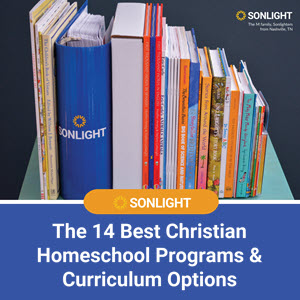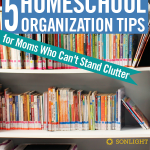Homeschooling is an open invitation to clutter. The minute we even consider homeschooling, clutter makes itself at home by way of picture books, paper, art supplies, science projects, curriculum, snacks, DVDs, and educational resources. Yet, homeschooling is also an open invitation to beauty, truth, and goodness. These are the reasons we homeschool and also the reasons we acquire picture books, art supplies, and educational resources.
How do we make room for more of the good stuff while not losing our minds over the clutter? With the following organization tips to control the clutter!

The homeschooler who doesn’t mind clutter is unusual. I, for one, don’t have that particular blessing. Clutter stresses me out and distracts me from the joys of homeschooling. It storms in the face of beauty, truth, and goodness.
Do you experience this, too? You aren't alone! In her article in Psychology Today about the mental cost of clutter, Sherrie Bourge Carter (Psy.D.) explains,
“Clutter can play a significant role in how we feel about our homes, our workplaces, and ourselves. Messy homes and workspaces leave us feeling anxious, helpless, and overwhelmed. Yet rarely is clutter recognized as a significant source of stress in our lives.”
Dr. Carter goes on to explain that clutter does the following:
- “distracts us by drawing our attention away from what our focus should be on.”
- “makes it more difficult to relax.”
- “inhibits creativity and productivity by invading the open spaces that allow most people to think, brainstorm, and problem solve.”
In other words, clutter can overwhelm the heart-and-soul of homeschool.
As I seek to foster a love of learning in our homeschool, part of my work is to manage clutter. It’s humble but meaningful work. Thankfully, with a few organizational habits, you and I can keep clutter at bay and create the atmosphere we envision.
1. Maximize Space
Start noticing the spaces in your home that you can strategically use. Can you find a better use for the top shelves in closets and the bottom drawers in cabinets? Does that top shelf hold useless or forgotten items that you can donate? Is there a bottom drawer in your home that is practically empty? Can you repurpose a coat closet or linen closet to hold homeschool materials?
I like to use top shelves for seasonal items like themed learning tools, blankets, decorations, beach towels, swimming supplies, boots. Bottom drawers are useful for items a young child uses regularly like bath toys, socks, favorite books, toys, and puzzles.
When you notice these underused storage spaces, you can then decide which items you want to store here. Bonus: by maximizing these storage spaces, you’ll free up storage space elsewhere that you can use more strategically.
2. Use Containers Deliberately
In my opinion, the right container in the right place for the right item can be a home’s best friend. Think about the things in your home that could be easily tidied and corralled into baskets, bins, and magazine holders.
Baskets
We have two large baskets behind the couch: one for cozy blankets, the other for board books. Any family member can tidy up the room by placing blankets and books in the appropriate basket.
We keep two additional large baskets by the front door: one for beach towels in the summer and snow pants in the winter; the other for lawn blankets (for reading under the maple tree) in fair weather and boots in cold weather.
Additionally, each person has a basket by the door that holds stuff that he or she grabs on the way out of the door, like ballcaps, mittens, socks, sunglasses, and wallets.
Bins
Clear plastic storage bins with latches are worth the investment. In our home, these sturdy items help with book and clothing storage as well as toy rotation.
Speaking of toy rotation—I’m a fan! (More on that later.) Plan the size of bin that you will need for each type of toy your child has (LEGO, Calico Critters, blocks, etc.) Label the bin clearly and store the bins in the basement, attic, or a closet. Even the youngest child can easily clean up his toys if all he has to do is return the toys to the bin. Whenever possible, I purchase clear bins so that we can easily see what is inside.
Magazine Holders
Use magazine holders to sort school books for each child according to the time of day that you use the resources or according to the subject matter. This keeps all of the related books and notebooks in one place and is easy to return to the shelf after use. Store the magazine holders on a shelf or in a closet.
A helpful side-note: when I want my child to take out the appropriate magazine holder and put it away when he’s finished, I include those steps in his assignment book. This gives him an easy check mark in his book, and he builds the habit over time.
3. Rotate the Tools for Fun
For our family, toy rotation is worth the investment of my time, energy, and strategy. If you’re unfamiliar with the term, toy rotation is making a few toys accessible to a child while storing other toys, then in time, exchanging the accessible toys with stored toys.
You can apply this rotation practice to puzzles, board games, math manipulatives, science kits, and any other hands-on resources you use for your homeschool.
Rotating the fun tools (toys) keeps our home tidy, opens up space, and allows our children to connect more deeply with their toys without feeling over-stimulated or distracted. At times, I’ve included toy rotation on my monthly to-do list; other times, I’ve simply rotated toys on a whim.
4. Declutter and Tidy
On one hand, I am an advocate of consistent, little-by-little decluttering, keeping a daily habit of tossing out broken things, donating unused things, and tidying up. On the other hand, I am an advocate of learning to tolerate a certain level of mess so that I can rest and relax without having everything in order all of the time.
I used to ask the kids to help me tidy the homeschool space and the playroom a couple of times a day, but now I’ve learned to let those spaces remain lived in until the end of the day when we do one big clean-up. I’ve discovered that I can live with the temporary clutter, and my children appreciate the room to breathe. It’s rewarding to pull things into order at the end of the day and to wake up to a calm and orderly home.
5. Practice Contentment
One of the secrets to a clutter-free life is contentment. This is especially helpful for homeschoolers. If you have a curriculum and resources that are working well, stick with them instead of looking for the next best thing. This curriculum consistency will provide many benefits to you—including less clutter.
Why Organization Matters
As in every life endeavor, our motivator mobilizes us to action: why will you and I work faithfully to manage clutter this year? My why is tucked in this excerpt from A Liturgy for Domestic Days.
“In the cleaning and ordering and
Maintenance and stewardship of things -
Of dishes, of floors, of carpets
And toilets and tubs,
Of scrubbing and sweeping
And dusting and laundering -
That by such stewardship
I might bring
A greater order to my own life,
And to the lives of any I am
Given to serve,
So that in those ordered spaces
Bright things might flourish:
Fellowship and companionship,
Creativity and conversation,
Learning and laughter
And enjoyment and health.”
-Every Moment Holy by Douglas Kaine McKelvey
Having an organized homeschool starts with an organized curriculum. See how Sonlight saves you time and keeps your lesson plans on track.










I enjoyed reading this article. I have found a routine for donating helps. I make a standing appointment with a local charity to stop by my house every Thursday for donation pickup. As I clean, I keep a brown paper bag on my front porch bench. Broken or unused toy items, and books I've hoarded but not read in 5 years, go in this bag. We call it the "magic bench" because every Thursday, all of the items on the bench magically disappear. Using this method, I have de-cluttered well and we have less mess. The mess robs me of joy, so I have a mission to remove the mess!
Thank you for writing this. I needed some encouragement and solutions, this was perfect.